Helpful information about
Sun Prairie, Wisconsin
Helpful information about
Sun Prairie, Wisconsin

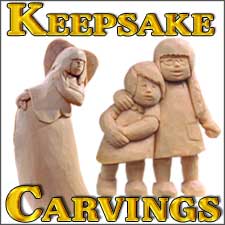
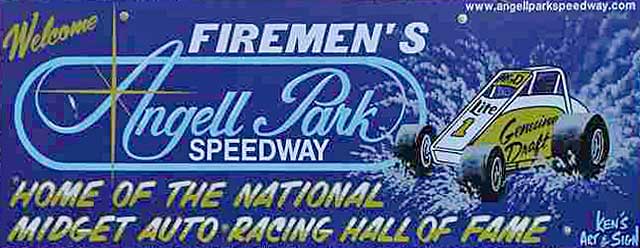
History Of Angell Park
On land originally donated by Colonel William Angell, the Sun Prairie Volunteer Fire Department has been providing the community of Sun Prairie with entertainment and a place to gather for over 100 years. From gridiron to ball diamond; dance hall to swimming pool; picnic area to festival grounds; and most importantly perhaps, horse track to speedway; dollar for dollar and acre for acre, nothing has put Sun Prairie on the map like Angell Park.
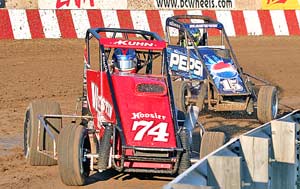 As a focal point of Sun Prairie, Angell Park once hosted the city's only community swimming pool. The pavilion has hosted band concerts, weddings and at least one funeral of sorts. Since 1955 the famed Sweet Corn Festival has been held here, drawing nearly 100,000 people during the four days of the event.
As a focal point of Sun Prairie, Angell Park once hosted the city's only community swimming pool. The pavilion has hosted band concerts, weddings and at least one funeral of sorts. Since 1955 the famed Sweet Corn Festival has been held here, drawing nearly 100,000 people during the four days of the event.
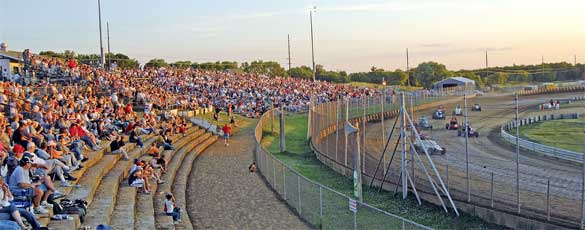
But what brings Sun Prairie and Angell Park their greatest notoriety is the speedway. Known world-wide as THE venue for midget auto racing, Angell Park Speedway had been hosting midget events since 1946. In partnership with the Badger Midget Auto Racing Association, Angell Park Speedway is a Sunday night tradition for many, during Wisconsin's summer months.
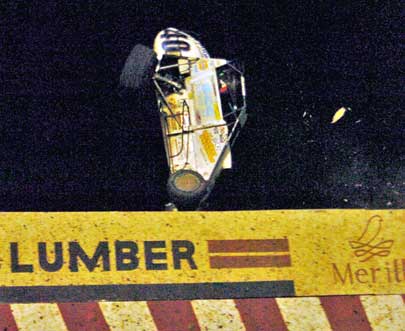 Angell Park has a long tradition of offering affordable family fun. We pride ourselves on presenting an exciting show on the track along with entertainment between races. Please visit our vendors for a souvenir or other diversion for the kids. Then check out our concession stands either in the pavilion or on the hill. Watch out for flying shirts! During the intermission, the crew will send T-shirts flying into the stands. The more noise you make, the better chance you have of one coming your way. Make sure you get the kids signed up for the new Kids Club too.
Angell Park has a long tradition of offering affordable family fun. We pride ourselves on presenting an exciting show on the track along with entertainment between races. Please visit our vendors for a souvenir or other diversion for the kids. Then check out our concession stands either in the pavilion or on the hill. Watch out for flying shirts! During the intermission, the crew will send T-shirts flying into the stands. The more noise you make, the better chance you have of one coming your way. Make sure you get the kids signed up for the new Kids Club too.
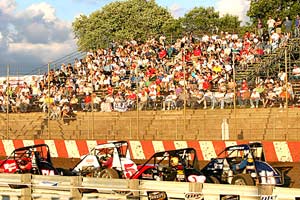 The speedway is unique in so many ways. We are proud to be the home of the National Midget Auto Racing Hall of Fame. Take some time and read the plaques honoring those who have made significant contributions to the sport. When the spectator gates open at 4:30, feel free to stroll the pits for a few minutes. Most drivers will be available for a quick photo or chat as they make last minute preparations to their cars. The local hero you meet today might just be the national racing star of tomorrow.
The speedway is unique in so many ways. We are proud to be the home of the National Midget Auto Racing Hall of Fame. Take some time and read the plaques honoring those who have made significant contributions to the sport. When the spectator gates open at 4:30, feel free to stroll the pits for a few minutes. Most drivers will be available for a quick photo or chat as they make last minute preparations to their cars. The local hero you meet today might just be the national racing star of tomorrow.
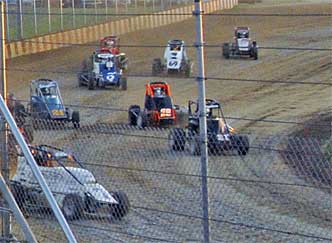 THE MIGHTY ROAR OF MIDGET AUTO RACING echoing through Wisconsin has been a tradition since 1934. Operating within the state since1936, the Badger Midget Auto Racing Association (BMARA) and its members, past and present, have played an important role in the development of the most exciting form of auto racing in America.
THE MIGHTY ROAR OF MIDGET AUTO RACING echoing through Wisconsin has been a tradition since 1934. Operating within the state since1936, the Badger Midget Auto Racing Association (BMARA) and its members, past and present, have played an important role in the development of the most exciting form of auto racing in America.
Available evidence indicates that the first organized midget competition held outside the State of California was conducted at the Blue Mound dog racing track located in Brookfield, Wisconsin during the month of July, 1934. Milwaukeean Ralph McDaniel was declared the winner of that historic race. The dog track, long since closed, is today the site of the Brookfield Square Shopping Mall.
Soon after the Brookfield race, midget racing was conducted at the Maitland cycle track which was located on what is now the Summerfest grounds on Milwaukee's lake front. In late 1934, under the promotion of Grover Horn, a cinder track designed for midget competition was constructed at the Wisconsin State Fair Grounds located in the Milwaukee suburb of West Allis. Tony Willman, who went on to race at Indianapolis and accomplish himself as a nationally recognized driver before his death in 1941, was declared the first fair grounds midget champion. The cinder track was eventually replaced by a quarter mile dirt oval that hosted weekly Friday night midget auto racing through the 1950 season.
Following the completion of the 1935 racing season in Milwaukee, local midget competitors got together and formed an organization that was to become known in later years as the Badger Midget Auto Racing Association. This forerunner to the BMARA was chartered originally as the Wisconsin Racing Association (WRA) .
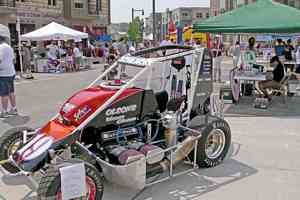 This new organization elected Carl Marchese, an innovative Indianapolis car owner, as its first president. Marchese remained as head of the group for two terms. Ted Tetterton was crowned the first WRA champion with Ray Richards taking the crown consecutively in 1937 and 1938.
This new organization elected Carl Marchese, an innovative Indianapolis car owner, as its first president. Marchese remained as head of the group for two terms. Ted Tetterton was crowned the first WRA champion with Ray Richards taking the crown consecutively in 1937 and 1938.
In 1938 the Wisconsin Racing Association changed its name to the Badger Midget Auto Racing Association. The change was necessitated by the need to avoid conflict with the newly formed promotional agency known as Wisconsin Auto Racing Inc. (WAR). Founded by Carl Marchese's older brother, Thomas, WAR promoted racing at the Wisconsin State Fair Grounds from 1938 to1967.
The midgets that ran under the BMARA banner before World War II consisted primarily of Elto outboard, J.A.P. motorcycle and Ford V8 - 60 powered machines. Considered class "B" cars locally, the Badger drivers competed on the same program with the A.A.A. Offy powered cars at the Wisconsin Fair Grounds quarter mile oval. The Badger drivers were awarded prize money at a lower percentage than that paid to competing A.A.A. cars in the same race. The Badger drivers found tough competition in the A.A.A. drivers they raced against. Such drivers as Shorty Sorenson, Wally Zale, Harry McQunn, Emil Andres, and the legendary Tony Bettenhausen were regular Milwaukee area competitors who always had first class equipment under them.
In addition to the Milwaukee Fair Grounds, the BMARA also sanctioned weekly races at venues such as Breeze-Stevens Field in Madison, Wisconsin, where talented drivers Ted Duncan and Bob Muhlke both took their first competitive rides in a midget race car. Other Badger sanctioned tracks included the DePere, Wisconsin fair grounds and the Horlick Athletic Field in Racine, Wisconsin.
In more recent years the Badger organization has competed on a regular basis at the now closed Hales Corners, Wi, Speedway, Charter Raceway in Beaver Dam,Wi. and in co-sanctioned events at the famous fair grounds oval in Knoxville, Iowa. Before Badger decided to concentrate on dirt tracks to cut costs, the club raced on paved ovals such as the Milwaukee Mile, Madison International Speedway in Oregon, Wi. and the Rockford Speedway in Illinois. Not until 1992 did the Badger group sanction their first indoor race. That first indoor event was held in the Milwaukee Arena.
ANGELL PARK
The Badger Midget organization has been sanctioning weekly Sunday midget auto racing at Angell Park Speedway in Sun Prairie, Wisconsin since 1946. This long standing tradition has made it difficult to separate the history of Angell Park speedway from the history of the BMARA as their legacies have become interwoven and inseparable.
Located 10 miles northeast of Madison, Wisconsin, Angell Park Speedway is situated within one of Sun Prairie's municipal parks. The park and its speedway are named after a local civil war colonel named William Angell who donated the land to the Sun Prairie Volunteer Fire Department in 1903. Since then the firemen have improved the facility with proceeds generated by the various entertainment venues presented in the park. Since 1946 revenue generated from the weekly midget races has helped to maintain the dance hall that overlooks the track, the pavilion that has been the home of the National Midget Auto Racing Hall of Fame (NMARHofF) since 2001, the concession stands that line the hillside above the track, and the various storage buildings necessary for track maintenance equipment.
Improvements to the speedway started as far back as 1945 when the Angell Park race course was shortened from a one-half mile trotter track to a one-third mile semi-banked, clay racing oval. Over the years the hay bales and trees that lined the perimeter of the course were replaced by wooden walls and by 1975 the entire perimeter was lined by concrete walls and double armco barriers that mark the inside of the track.
The tradition of Sunday night racing at Angell Park began in 1948 when lighting was first installed at the track. Improved Musso style lighting suitable for televised events were brought in prior to the 1990 season. Sadly, the placement of the new lighting system meant an end to the old shade trees that grew among the spectator bleachers.
With increased noise pollution regulations continually being imposed on race tracks nationwide, the sight of brightly painted, snaring midgets racing down the backstretch at Angell Park as the setting sun silhouettes the downtown buildings adjacent to the speedway is one of the rare sites left in racing today. The tradition of Sunday night racing at Angell Park Speedway was only broken once. In 1966 the races were run on Saturday nights but the success hoped for did not occur. In 1967 the races were returned to their traditional Sunday night spot.
Adding to the uniqueness that is synonymous with Sun Prairie is the fact that midget auto racing is the only form of racing to ever headline the Sunday night tradition at Angell Park. The track has welcomed various sprint car, and legend car groups to share special events but Angell Park has never relied on a permanent support division to bolster attendance.
THE DRIVERS
Over the years, Angell Park and the Badger organization have not only developed as a first class racing facility and sanctioning body respectively, but they also have become known as a starting point for many legendary race car drivers. In fact, it is hard to determine who was or is the best driver to graduate from the Badger organization and move on to compete at the national level. The list of championship caliber drivers is long and very impressive.
The first Badger graduate to make it to the qualifying line for the Indianapolis 500 was Bob Cleberg. A journeyman driver, Cleberg drove for the top owners in Badger during the 1950's. Making a name for himself driving for Badger car owners Kenny Edge and Vance Moore, Cleberg made his only appearance at Indy in 1960. Bob qualified the Bell Truck Lines Special but was bumped from the 500 field and served as first alternate.
Leading all time USAC midget auto feature race winner and seven time USAC National Midget Champion Mel Kenyon, raced with the Badger organization for several seasons starting in 1958. At the urging of Badger competitor Elver Lund, Mel came to Wisconsin and competed at Sun Prairie and other Badger venues driving his own Ford tractor powered midget that carried the traditional No. 61.
Ignoring sprint car racing for the most part, Kenyon went on to become a respected Indianapolis car driver. Mel recorded the highest Indianapolis 500 finish of any Badger graduate when he drove to third place in the 1968 Memorial Day Classic.
One the most crowd pleasing drivers to ever don a racing helmet in America started his open cockpit career at Sun Prairie. Tom Bigelow of Whitewater, Wisconsin, who is the all time leading USAC sprint car feature race winner and 1978 USAC National Sprint Car Champion, broke into midget racing competing with the Badger organization in 1959. Bigelow won the Sun Prairie driving championship in 1964 driving a car owned by Bud Doty out of Davenport, Iowa.
In 1965, Bigelow moved on to International Motor Contest Association (IMCA) sprint car racing and was named that organization's rookie of the year. Bigelow went on to qualify for the Indianapolis 500 nine times with his best finishes being a sixth in 1977 and an eight in 1980. After winning the 1984 USAC National Midget Championship, Tom returned to Angell park in 2002 to be inducted into the NMARHof F. Another Badger graduate who made his mark in open cockpit racing is Rich Volger. Volger drove in his first ever midget races at Sun Prairie on July 27, 1969 driving a Chevy II powered car owned by his father, Don. Volger went on to win 134 main events and nine championships in USAC competition second only to A.J. Foyt's 159 wins and thirteen championships. Rick also won the 1973 National Alliance of Midget Auto Racing (NAMAR) National Championship and the inaugural Chili Bowl Championship in 1987. At the Indianapolis Motor Speedway Vogler qualified five times for the 500 with his finish coming in 1989 when he finished eigth after starting 33th.
On July 21, 1990 Volger qualified for his first NASCAR Winston Cup Race at Pocono, Pa. Later that day Vogler flew to Salem, Indiana to compete in an ESPN televised USAC sprint car race. On the last lap of the feature Vogler was fatally injured while leading the event. With the red flag displayed and the running order reverting back to the last green flag lap, Vogler was declared the winner of his last race.
Gary Congdon, who flipped his Tassi Vatis racer over the nose of Don Branson's car during the first lap accident at the Indianapolis 500 in 1966, was a former Badger competitor. Gary drove the very unique Ernie Fredrickson Novi styled roadster with great success in Badger competition before moving into championship car racing. Unfortunately, Congdon was fatally injured on September 24th, 1967 racing in the famed "Hut Hundred" midget race held at the Vigo County fairgrounds in Terre Haute, Indiana.
Indianapolis veteran and NMARHof F member Bill Engelhart started his professional career at Sun Prairie. Named the 1967 Badger rookie of the year, Engelhart scored many feature wins throughout Wisconsin driving cars owned by Gene Willman of Hales Corners,Wi.. Engelhart later moved into USAC midget competition driving an Offy powered car for long time Badger member Vance Moore of Portage, Wisconsin. Named USAC midget racing rookie of the year in 1969, Engelhart 's continued efforts led him to the Indianapolis 500 in 1980 where he finished eleventh. Two years later Engelhart returned to Sun Prairie and won the inaugural Fireman's Nationals.
Winning nine straight feature events on his to the 1979 Badger championship, Stan Fox of Janesville, Wisconsin is another Badger competitor who gained national recognition. Fox has been described as one of the last drivers to make the link between midget racing and competing in the Indianapolis 500.
After graduating from Saint John's Military Academy in Delafield Wi., Stan raced midgets and earned rides at Indianapolis driving for the likes of A.J. Foyt and Ron Hemelgarn. Remembered for surviving a horrific crash on the first lap of the 1995 Indy 500, Fox always returned to his roots at Angell Park. The eight time Indy qualifier was often seen as a spectator at Sun Prairie before his untimely death in an automobile accident while visiting New Zealand in 2000.
With open wheel drivers today looking to stock cars as the way to advance their professional careers, Sun Prairie and the Badger organization continues to play an important role in the development of new talent. NASCAR champions Jeff Gordon and Tony Stewart have both collected Angell Park midget feature wins on their way to racing stardom. Gordon won at Sun Prairie on July 14, 1990 driving the Rollie Helming Pepsi entry as he raced to the 1990 USAC National Midget Championship.
Stewart has three Badger feature wins to his credit including one Sun Prairie win and a 100 lap victory at the Hales Corners Wi. Speedway on July 30, 1992. In addition to Gordon and Stewart, Kasey Kahne, Jason Leffler, J.J.Yeley, Aaron Fike, and Bryan Clauson all raced at Sun Prairie as they worked their way to NASCAR's top levels.
THE BEST OF THE BEST
The drivers with the best records and the most championships in the Badger organization belong to two local racers who stayed close to home, but still became recognized as great drivers on a national level.
Racing out of Kenosha, Wisconsin, Billy Wood won a record eight Badger championships during his career. Wood won his first championship in 1954 and his last in 1968. His championship run included a string of four consecutive driving crowns between 1957 and 1961. As an employee of American Motors in Kenosha for 38 years, Wood never raced more than 150 miles from his home. Even with this self imposed restriction he still became a very respected racer in USAC as well as Badger. Wood was inducted into the NMARHof F in 2002 along with Tom Bigelow.
The only driver to rival Wood's eight Badger championships is Danny Boorse of Whitefish Bay, Wi. Boorse claimed seven Badger championships between 1984 and 2001 and finished second in points five other times. Boorse is also the all time feature win leader at Sun Prairie and a two time Chili Bowl champion. In winning his second Chili Bowl in 2003 Boorse had to beat Jay Drake and Tony Stewart to the line in one of the best finishes in Chili Bowl history. In victory lane Boorse immediately stated that his win was dedicated to everyone back in Sun Prairie. Curtailing his racing activities as of late, Boorse will most likely be the next Badger champion inducted into the NMARHof F.
Also included in the list of Badger champions who stayed at the local level but still became legendary in their own right are Miles Melius (1949,50) and Billy Johnson (1948,53). In the 1960's Melius and Johnson became dominate forces in Milwaukee area modified stock car racing. In recognition of their accomplishments both men were named as charter members to the Southeastern Wisconsin Short Track Hall of Fame in 2007. At the induction ceremony NASCAR great Bobby Allison stated that Melius was one of his early mentors and was a positive influence in his successful career.
Determining who has the best record as a car owner in Badger is very difficult. There is Frank Farchione, Ernie Fredrickson, Walter and Harry Whitehorse, John Heisdorf , Jim Fiscus, and the Wilke Brothers to consider. There is however, one car owner that put together a very competitive team in the1960's that could be considered the best in club history
The Dari-Kool racing team out of Madison, Wi. was owned by long time Badger official Paul Krueger. Between 1961 and 1968 Krueger's drivers brought six driving championships and five car owner championships to the team. Keith Thomas won three driving championships (1961,62,65), Ron Erfurth one championship (1964), and Billy Wood won two championships (1966,68). In that same time period Krueger's blue and gold racers accounted for five car owner titles (1962,64,65,66,68). In 1965 the Dari-Kool cars finished first and second in owner points and in 1966 first and second in both driver and owner points. By the end of the 1968 season, the eleven championships won by the Dari-Kool team had set a standard of consistency that future car owners could use as a measure for success.
SECOND GENERATION CHAMPIONS
The tradition that as grown at Sun Prairie and within the Badger organization has seen the rise of second generation drivers who came to hold their own on the same tracks that were mastered by their fathers. The sons of Badger champions Al Fredenberg (1956), Ron Erfurth (1964), and Dave Ray (1977), have won their own Badger championships.
Dan Fredenberg was crowned the 1981 Badger champion and was presented with the same championship trophy presented to his late father 25 years earlier. Al Fredenberg was fatally injured in a racing accident at Sun Prairie in 1963. Driving his own car, Dan also won the car owners championship that year. Winning both championships was a difficult task as Badger ran 30 events in 1981, with 23 being conducted on dirt tracks and seven run on paved tracks.
Dean Erfurth won the Badger Title in 1990 driving for Jim Fiscus and Davey Ray won the 2003 championship in spectacular style driving a car owned by Ralph Wilke
IN THE STANDS
Even some spectators who sat in the old tree lined grandstands at Sun Prairie have become famous. Doug Wolfgang, who lived as a teenager in Beloit, Wisconsin has stated that it was watching the midgets run at the "Prairie" that convinced him he had to race open cockpit cars when he came of age.
The founder of the World of Outlaws sprint car circuit, Ted Johnson, was first introduced to racing at the Sun Prairie oval while he was still a high school student living in Madison. Before moving to Oklahoma and establishing the World of Outlaws, Johnson worked on cars driven by Badger driver Billy Horstmeyer of Stoughton, Wi. Horstmeyer died in a USAC Championship Car race at Springfield, Illinois in August of 1964..
World of Outlaw champion Steve Kinser is married to the former Dana Snyder who is the daughter of two time Badger champion Owen Snyder. Snyder raced under the name of Todd Barton to avoid problems with an employer who did not share Owen's interest in racing. Snyder drove midgets and sprint cars for the Chief Automotive Team owned by the Whitehorse Brothers of Madison, Wi.
UNIQUE CARS AND ENGINES
The unique race cars that have been constructed by Badger members are as noteworthy as the drivers who have developed their talents at Angell Park and other sanctioned tracks around the state.
The first president of the Badger Midget Association, Carl Marchese, may have been the most innovative member. Along with his brother Tudy, Carl developed many "first's" in midget car design. The Marchese brothers built the first tube frame midget in 1935. In that same car was housed a four cylinder Miller engine that had started life as a straight eight designed for Indianapolis car competition. Carl and Tudy were also among the first to supercharge midget engines, experiment with duel rear wheels and develop a workable torsion bar suspension. In recognition of his accomplishments, Carl was inducted into the NMARHof F in 2007.
Until 1966 when Badger first accepted the Offenhauser as a legal racing engine, the organization operated with a stock block oriented rule book. The majority of engines used in Badger competition at that point in time were of the Chevy II and Ford Falcon variety housed in older Kurtis Kraft style frames. That set of rules however, saw the development of many successful V8 midget power plants. Two of the more successful V8's were developed by Frank Farchione of Franksville, Wi and Frank Kater of West Allis, Wi..
Farchoine converted an Oldsmobile F85 V8 into a very potent race engine. The late Bill Horstmeyer drove the Farchione Olds with great success for many years and established himself as one of the better drivers to have ever competed with the BMARA.
The Buick V8 developed by Frank Kater won one of the most important races ever sanctioned by the BMARA. The Buick Special V8, housed in an older Hillegas chassis and driven by Leon "Jigger" Sirois, won the 100 mile midget event conducted on the Wisconsin State Fair Park one mile paved oval during the 1965 running of the Wisconsin State Fair. The Kater Special was also one of the first midgets in the country to be equipped with a full roll cage. The cage on the Kater Buick appeared as early as 1966. Following some driver displeasure at the time of its original mounting the cage was removed and did not reappear until cages were made mandatory a few years later.
The development of the Chevy based Sesco midget race engine has a strong connection to the Badger organization as well. The creator of the Sesco engine, NMARHofF member Ron Hoettells of Milwaukee has worked closely with many Badger members throughout the years. The first test run of the prototype Sesco Chevy was conducted in the shops of Badger driver Don Boorse in the late 1960's.
The Badger organization, fully aware of the potential the Sesco had, banned the engine before it was marketed in an attempt to avoid equipment obsolescence within the club. For this reason, the actual track testing and development work was done by various teams competing in USAC sanctioned midget competition.
By 1976, the Sesco and other exotic racing engines were legal and accepted within the Badger organization. This situation opened the door for track testing and development of the Sesco Chevy 2x4 engine in Badger competition. Hoettells hoped to counter the V.W. midget engine with his new opposed cylinder Chevy based engine. One of the first prototypes was placed in the Vance Moore car driven by former Badger champion Lars Lein. After development, the 2x4 concept never attained the success generated by the V.W. and Hoettells started looking for a different engine combination. In recent years Hoettels has been involved in the development of the Sesco Mopar midget engine that has been successful at midget tracks across the country.
In May of 2001 the first ever feature win by a Mopar midget engine occurred at Sun Prairie. Davy Ray drove a Beast chassis owned by Harlan Kittleson and powered by a Gary Stanton built Mopar to the popular victory.
Two cars that were one of a kind creations and unique to midget racing were the rear engine midgets of Amos Jentz and Bob Drestrka. These midgets were unique because they not only competed on dirt ovals but they also won feature events on dirt as well. The Jentz creation, powered by a Harley-Davidson motorcycle engine, was driven to victory in a Badger sanctioned race conducted at the Four Wheel Drive test track in Clintonville, Wisconsin in 1939 by Milwaukee area driver Fritz Kutner.
Drestrka's rear engine car was built in 1972. It featured an Outboard Marine Corporation two cycle engine housed in a one of a kind tube frame which incorporated a unique I beam rear suspension. Chuck Dann of Milwaukee drove the car to victory at Sun Prairie in July of 1976. Banned by USAC because of its rear engine design, the car never received the national recognition it should have. Running primarily with the Badger circuit, it was seldom seen in competition outside the state of Wisconsin.
In 1987 Badger members Greg and Mark Wilke built one of the most successful midgets ever to race at Angell Park. Their car was of their own design and powered by a Ford Cosworth engine. Driven by NMARHofF member and five time Badger champion Kevin Olson, the Wilke team did what many thought would be impossible to accomplish. In addition to winning the 1987 Badger championship, Olson also drove the Wilke creation to the 1987 USAC National Midget Championship.
During the 1988 season Olson so dominated Badger competition in the Wilke car that a bounty was offered to any driver who could beat the white number 11. Olson prevailed and won the 1988 championship by 104 points. In addition, Rick Vogler drove the same car to the 1988 USAC National Midget Championship.
The 2005 season saw another dominating performance as Scott Hatton, driving the Dwight Huston Pepsi sponsored entry won the Badger championship in convincing style. As the former Chili Bowl winner raced to his third Badger championship Hatton won eight features, finished in the top five 16 times, and won the title by 268 points. Included in his list of feature wins were the USAC sanctioned Hall of Fame Classic and the season ending Fireman's Nationals which were held on consecutive weekends at Angell Park.
YEARS OF CONCERN
In terms of longevity, no other midget racing organization can claim to have been in existence longer than the BMARA. The Badger organization has conducted monthly general membership meetings without interruption since its inception in 1936. With the exception of the war years (1943-45), the Badger organization has continuously sanctioned weekly midget racing in the state of Wisconsin since 1936.
Badger's ability to sanction races on a continuous basis is unique from the stand point that Badger rules forbids the club to promote their own racing events. Fortunately, the Badger organization has always been strong enough to give promoters a viable product that can be presented to the racing public year after year in a worthwhile fashion.
Like all racing organizations, Badger has had years where car shortages and internal conflict were present. In 1969 weekly midget racing at Angell Park almost came to an end. Early in the 1969 season there were rumors that things were not going well between the BMARA and the Sun Prairie firemen. On July 27th the Sun Prairie firemen announced that they were canceling the remainder of the 1969 season due to low spectator attendance and poor weather. That decision left the Badger organization without a weekly venue for the remainder of the season.
For the 1970 midget racing season ownership of Angell Park stayed with the firemen while promotion of the midget races was taken over by Elmer Tiegs of Madison, Wi. The BMARA returned as the sanctioning body for the weekly Sunday night races. Under Tiegs promotion the first ever co-sanctioned BMARA - USAC midget race was held at Angell Park on August 30, 1970 with USAC driver Larry Rice winning in a car owned by Badger member Gene Willman.
Tiegs and his Midwest Auto Racing Championship Association Inc. started the 1971 season again promoting Sunday night BMARA sanctioned races. On August 10th of that year Tiegs announced that he was canceling his sanctioning agreement with the Badger group claiming that low car counts and poor race management on the part of the BMARA was affecting his ability to promote the races properly. Tiegs finished out the season with a series of USAC national championship midget races that featured some excellent driving on the part of 1971 USAC Midget Champion Danny Caruthers.
Before the start of the 1972 season the Sun Prairie firemen took Tiegs to court for violations of the promotional contract. The end result was that the firemen regained control of the promotional rights at Angell Park and have exclusively promoted the races at Angell Park with The BMARA as the primary sanctioning body ever since.
GOOD YEARS AND A SUCESSFUL CLASSIC
Since 1972 the Sun Prairie firemen and the BMARA have worked hard to continually improve the only weekly midget auto racing program in America. The result of this work is a strong weekly program that regularly draws at least 30 cars and attendance that is able to support an attractive weekly purse.
In addition, the year ending Sun Prairie "Firemen's Nationals" has grown to become one of the most important annual midget races in America. In a rare showing of cooperation the top USAC midget teams competed in the 2007 running of the Fireman's Nationals even though there was no official USAC sanction. Midget teams owned by Tony Stewart, Kasey Kahne, and Steve Lewis appeared along with the best of Badger and USAC to produce one of the strongest fields ever seen at Sun Prairie. The winner was Badger regular and two time USAC National Midget Champion Jerry Coons Jr. driving a Wilke owned car. This event has evolved since its beginnings in 1982 to the point where the 2008 Nationals will carry a total purse of $35,000 for the one day season ending event.
The array of "Fireman's Nationals" winners has become an impressive list of the best midget racers in America. The unique trophy that goes to the winner of this Labor Day weekend classic has become a symbol of the Sun Prairie tradition of the local fire fighters and the Badger Midget Auto Racing Association working together to provide the best clay track midget racing in the world.
CONCLUSION
As automobile racing enters the 21st century The Badger Midget Auto Racing Association will continue to be a force in the development of new talent for the racing industry. As the oldest sanctioning body in the United States, the experience and knowledge that its members have gained over the years will allow the BMARA to continue its role as one of the leading racing organizations in American motorsports.